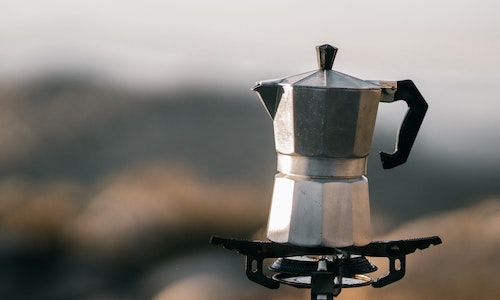What happens when you open your moka pot to begin making a fresh brew, only to find it filled with mold? It’s a frustrating situation to find yourself in, but don’t worry, in this article, I will be explaining in detail exactly what you need to do in order to thoroughly clean your Moka pot of mold and make it as good as new.
To clean mold from an aluminum Moka pot, fill both chambers with water and bring it to a boil for ten minutes to kill the mold. Once cooled, pour the water away, disassemble the pot, and use a mild detergent to remove any residual mold. Leave it to dry completely before using it again.

Related articles
Moldy Coffee And Mycotoxins: Do You Need To Worry?
Mold In Coffee Grounds: Can They Damage Your Plants?
How to clean a Moka pot that’s moldy
Luckily, the process to clean Moka pots is fairly simple. You do, however, need to be careful to take note of the material your pot is made from, or you could end up damaging the interior lining.
For instance, if your pot is made out of aluminum, vinegar, or other highly acidic cleaning products could corrode the metal and produce a foul-tasting brew on the next use. If your pot is made out of stainless steel, you would be fine to use vinegar or other more acidic cleaning products.
cleaning products could corrode the metal and produce a foul-tasting brew on the next use. If your pot is made out of stainless steel, you would be fine to use vinegar or other more acidic cleaning products.
As all molds have the potential to cause symptoms in people with allergies, and some are known to produce harmful mycotoxins, it is best to wear protective gear before handling or cleaning a moldy moka pot.
Recommended safety equipment includes eye protection, a breathing mask, and rubber gloves. With that being said, here are the steps you need to follow to effectively remove mold from both aluminum and stainless steel Moka pots.
Cleaning an aluminum Moka pot with mold
Aluminum pots and pans react with many cleaning materials, even some of the less harsh ones such as vinegar or baking soda.
Because you do not want to damage your Moka pot and spoil the taste of future brews, I recommend you use a mild detergent.
To clean an aluminum Moka pot with mold in it, use the following steps:
- Disassemble your Moka pot entirely.
- Make a solution of mild detergent with warm water.
- Clean each part of the pot thoroughly, paying close attention to any hard-to-reach areas.
- Rise out with clean water
- Fill with fresh water and boil for ten minutes
- Allow to cool and empty the water
- Allow the pot to completely dry before reassembling and storing it away.
How to clean a stainless steel Moka pot of mold
Stainless steel is a much hardier material than aluminum, which means it can handle more acidic and generally more powerful cleaning products without fear of corrosion.
material than aluminum, which means it can handle more acidic and generally more powerful cleaning products without fear of corrosion.
To clean a stainless steel Moka pot of mold, use the following steps:
- Make a solution of 1 part distilled vinegar to two parts water and pour it into a spray bottle.
- Disassemble your Moka pot and liberally spray the components with the vinegar solution.
- Leave the vinegar solution to work for ten minutes.
- Using warm water and detergent, wash the dead mold and vinegar residue off the pot, using a toothbrush or soft-bristled brush to work the mold out of difficult-to-reach areas.
- Rinse the pot with clean water and refill
- Bring to the boil for ten minutes
- Allow the Moka pot to completely dry before storing.
What types of mold grow in a Moka pot?
The most commonly found strains of mold found growing in Moka pots tend to either be white, green, or black in color. Some of these strains can be pretty harmful to humans, and I will explain below which strains could relate to each color and whether or not any extra care needs to be taken when removing them.
White mold
White, powdery growth within your moka pot could indicate either Aspergillus or Penicillium
or Penicillium strains are present, as both can present with a white to grey coloration and have powdery or fluffy textures. Aspergillus is known to produce mycotoxins
strains are present, as both can present with a white to grey coloration and have powdery or fluffy textures. Aspergillus is known to produce mycotoxins , so extra care should be taken when handling or cleaning.
, so extra care should be taken when handling or cleaning.
Black mold
Stachybotrys Chartarum is also known as black mold, and this could be the strain of mold growing in your moka pot. However, this is relatively unlikely. Alternaria
is also known as black mold, and this could be the strain of mold growing in your moka pot. However, this is relatively unlikely. Alternaria , Cladosporium
, Cladosporium , and Ulocladium
, and Ulocladium strains often appear with very dark coloration that could be mistaken for true black mold, these strains are not known for being particularly harmful to humans, but people with allergies should take extra care, as symptoms could still present from inhalation of their spores or coming into contact with them.
strains often appear with very dark coloration that could be mistaken for true black mold, these strains are not known for being particularly harmful to humans, but people with allergies should take extra care, as symptoms could still present from inhalation of their spores or coming into contact with them.
Green mold
Aspergillus and Penicillium strains both come in green coloration and again often have a powdery or fluffy texture to them. Aspergillus and Penicillium strains are known to be able to produce mycotoxins that can cause serious harm if ingested, (especially in those with weakened immune systems). It is for these reasons that handling and cleaning a moka pot that has an infestation of these strains should be done whilst wearing the safety equipment suggested.
Is the mold that grows in a Moka coffee pot dangerous?
Depending on the strain of mold you are dealing with, you could be facing either a toxic or non-toxic variety. Unfortunately, without testing, you will not be able to tell if the mold in your Moka pot is indeed toxic or not.
Some molds can release metabolites called mycotoxins when they feel threatened. If these mycotoxins are ingested or inhaled in large enough quantities or over long periods, they can cause harm to humans.
If you were to unknowingly be drinking moldy coffee for a prolonged period of time, the mycotoxins you would be ingesting or inhaling could cause any of the following symptoms :
:
- Nausea
- Breathlessness
- Vomiting
- Gastrointestinal discomfort
Why do Moka pots become moldy?
Mold is not picky about where it lives and grows, as long as the circumstances are correct, it will grow pretty much anywhere it can. Unfortunately, this includes a Moka pot that’s been left on the kitchen counter for a few days with old coffee left in it.
If you do not properly clean a Moka pot after last using it, there will be tiny remnants of coffee grounds, this is what the mold strains use for nutrients.
There is also plenty of moisture left in Moka pots from either leftover coffee or from steam that condensed to form water droplets on the lid.
A source of moisture and nutrients are the basics that mold needs to grow. When you couple that with the fact that you may have left the pot on a kitchen counter or by the sink in a nice warm kitchen, you have given mold everything it could possibly need.
How to prevent mold growth in a Moka pot
Preventing mold from growing in a Moka pot is a simple process, you simply need to make sure that mold does not have what it needs in order to live, which are mainly nutrients and moisture.
Ensure after each use of a Moka pot, you thoroughly clean it with warm soapy water, making sure there are no coffee grounds left in any part of the pot, including the filter. Once clean, allow the pot to air dry fully before storing it away again.
As long as there are no remnants of coffee and no moisture trapped in any parts of the pot, mold will find it very hard to grow.
What are the white spots in your Moka pot?
Upon first glance, you may think that the white residue you’ve seen forming in your Moka pot could be mold formation.
The good news is that this is almost certainly not the case. Instead, what you may be seeing is a buildup of calcium deposits (if you live in a hard water area ), much like you would see in the bottom of an electric kettle. It could also be the natural oxidization of the aluminum the pot is made out of as a result of it not being dried properly after cleaning.
), much like you would see in the bottom of an electric kettle. It could also be the natural oxidization of the aluminum the pot is made out of as a result of it not being dried properly after cleaning.
In either case, scrubbing the pot with vinegar and warm water will remove these deposits, and once dried correctly, the pot should be back looking like it was just purchased.
Conclusion
Mold can easily be cleaned from an aluminum moka pot by boiling the pot to kill the mold, then cleaning with warm water and mild detergent. For stainless steel pots, vinegar or lemon juice can be added to the water whilst it boils.
Over to you
I hope this article has given you some guidance on how to clean mold out of your moka pot and hopefully how to stop it from coming back, but now I’d like to turn things over to you. Have you ever drank coffee from a moldy coffee pot? Or have you got any extra tips that you think could be good to add to this article? If so, I’d love to hear all about it, so please leave a comment below and I’ll get back to you ASAP.

